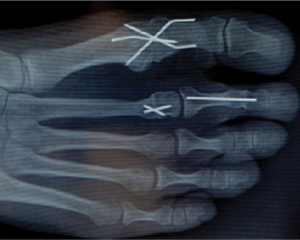FDA Gives 510(k) Clearance to 3D Printed Titanium Digital Fusion Implant – First Product from Additive Orthopaedics
 Some of the most delicate bones in the body are those in the extremities. While a broken finger or toe is obviously not as debilitating as, say, a broken arm or leg, they’re still painful and, in some cases, can have complications. The bones in the toes are particularly tricky – there’s a lot that can go wrong with them, breaks or not. Those delicate little bones do a lot of work and carry a lot of weight, so it’s important to make sure they heal correctly, and sometimes a little extra help is required.
Some of the most delicate bones in the body are those in the extremities. While a broken finger or toe is obviously not as debilitating as, say, a broken arm or leg, they’re still painful and, in some cases, can have complications. The bones in the toes are particularly tricky – there’s a lot that can go wrong with them, breaks or not. Those delicate little bones do a lot of work and carry a lot of weight, so it’s important to make sure they heal correctly, and sometimes a little extra help is required.
Digital fusion refers to a procedure in which the bones of the toe are fused together after a surgery, and occasionally they require stabilization from a pin or implant while they grow together and heal. New Jersey-based Additive Orthopaedics, LLC is a brand new company dedicated to the development of 3D printed orthopedic devices specifically for the extremities, and their first product, a 3D printed titanium digital fusion implant, has just been given 510(k) clearance from the FDA.
3D printing has made a major impact on the orthopedics industry lately, largely thanks to the development of metal printing technologies. The devices that get the most attention tend to be the big, potentially lifesaving implants like those for the neck and spine, but there are a lot of great things being done for bones elsewhere in the body – like the feet and hands – that shouldn’t be ignored. One of the biggest benefits of additive manufacturing in orthopedics is its ability to customize. Traditionally manufactured implants tend to be “one size fits all,” but the human body isn’t one size fits all, and an ill-fitting implant can lead to complications in the healing process. That’s what Additive Orthopaedics is trying to change with their customized, patient-specific implants.“Additive manufacturing allows us to develop complex geometries at reasonable manufacturing costs not possible before now with traditional manufacturing,” said Greg Kowalczyk, President and Founder of Additive Orthopaedics. “Design teams really need to think outside the box when considering this innovative manufacturing process. And where better to do that then the Global US Extremity Market valued at $1.3 billion and growing at over 10% per year. We are confident that the market will respond well to this, our patient specific products in development, and our other devices currently being reviewed by the FDA.”
 Additive Orthopaedics is still in the earliest stages; they just moved past their initial seed funding rounds and have just announced their second round of funding. One of the company’s investors is Asimov Ventures, the venture capital firm launched last year to support early-stage startups in 3D printing and robotics. They’ve already invested in several promising companies that have really taken off, like Wiiv and Metamason, and with their flagship device already FDA approved, I expect Additive Orthopaedics is soon to take off as well. They’re certainly in the right market.
Additive Orthopaedics is still in the earliest stages; they just moved past their initial seed funding rounds and have just announced their second round of funding. One of the company’s investors is Asimov Ventures, the venture capital firm launched last year to support early-stage startups in 3D printing and robotics. They’ve already invested in several promising companies that have really taken off, like Wiiv and Metamason, and with their flagship device already FDA approved, I expect Additive Orthopaedics is soon to take off as well. They’re certainly in the right market.
“3D printing has a major role in the future of orthopaedics,” said Dr. Selene Parekh, Professor of Surgery in the Department of Orthopaedic Surgery at Duke Orthopaedics and North Carolina Orthopaedic Clinic. “In today’s cost sensitive health care environment, 3D printing allows us to bring highly complex, lower cost technologies to the market very quickly, with patient specific features that will potentially improve patient outcomes.”
Discuss further in the Additive Orthopaedics Gains FDA Clearance for 3D Printed Implants forum over at 3DPB.com.
Subscribe to Our Email Newsletter
Stay up-to-date on all the latest news from the 3D printing industry and receive information and offers from third party vendors.
You May Also Like
Precision at the Microscale: UK Researchers Advance Medical Devices with BMF’s 3D Printing Tech
University of Nottingham researchers are using Boston Micro Fabrication‘s (BMF) 3D printing technology to develop medical devices that improve compatibility with human tissue. Funded by a UK grant, this project...
3D Printing Webinar and Event Roundup: April 21, 2024
It’s another busy week of webinars and events, starting with Hannover Messe in Germany and continuing with Metalcasting Congress, Chinaplas, TechBlick’s Innovation Festival, and more. Stratasys continues its advanced training...
3D Printing Webinar and Event Roundup: March 17, 2024
It’s another busy week of webinars and events, including SALMED 2024 and AM Forum in Berlin. Stratasys continues its in-person training and is offering two webinars, ASTM is holding a...
3D Printed Micro Antenna is 15% Smaller and 6X Lighter
Horizon Microtechnologies has achieved success in creating a high-frequency D-Band horn antenna through micro 3D printing. However, this achievement did not rely solely on 3D printing; it involved a combination...






























